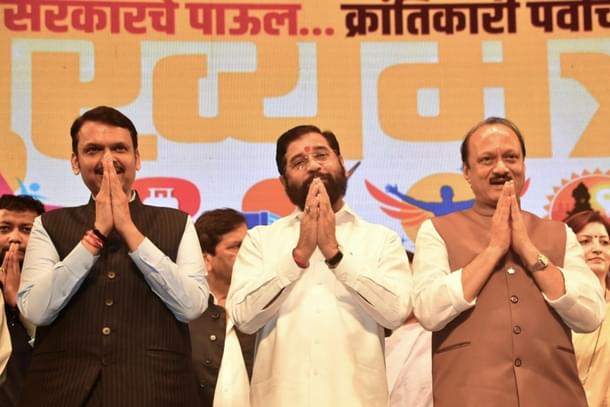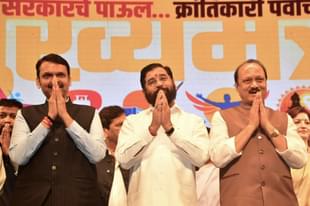Politics
The Mahayuti Blockbuster: How The BJP And Its Allies Turned The Tide In The Maharashtra Assembly Polls
Krishna Dange
Nov 24, 2024, 05:33 PM | Updated Dec 27, 2024, 02:38 PM IST
Save & read from anywhere!
Bookmark stories for easy access on any device or the Swarajya app.


In the Maharashtra State Assembly poll results announced on November 23, 2024, the Bharatiya Janata Party (BJP) led ruling Mahayuti coalition comprising its allies the Eknath Shinde led Shiv Sena (SS) and the Ajit Pawar led Nationalist Congress Party (NCP) won 236 out of 288 seats – an unparalleled feat in the state’s coalition politics history.
On the other hand, the Maha Vikas Aghadi (MVA) comprising the Congress, the Uddhav Thackeray led Shiv Sena (SS-UBT) and the Sharad Pawar led Nationalist Congress Party (NCP-SP) managed to win 49 seats. This came has a huge setback to the coalition of the opposition parties as this was lower than even the worst case scenario of 69 to 121 seats predicted by an exit poll agency.
Ask any political cadre in the state about the nature of politics here and they will unanimously say, “doing politics in Maharashtra is difficult.”
This is evident from the fact that the state has seen three chief ministers between 2019 to 2024. This includes BJP leader Devendra Fadnavis’s tenure, cut short within two days post his swearing-in after the undivided Sena of the past under its chief Thackeray decided to break ties with BJP and join the opposition to form the MVA. Thackeray made this move then after an invite extended by Sharad Pawar, the chief of the undivided NCP of the past.
The BJP along with its leader Fadnavis soon managed to bounce back into power in 2022 after Shinde wrested control of the undivided Sena from Thackeray. They were soon joined by Ajit Pawar, who took control of the NCP from his uncle in a similar fashion.
The three parties collectively fought the 2024 Lok Sabha election. But despite this allure of the ‘double engine sarkar,’ it was Maharashtra along with Uttar Pradesh where the BJP led coalition performed poorly, winning 17 out of 48 seats in the former, down from 42 seats won twice in the past.
Come November 2024, at a time when the poll pundits predicted a nearly hung assembly, the BJP under the charge of the same Fadnavis trounced its opponents on 132 seats, breaking its previous record of having won 128 seats back in 2014. This is remarkable moment as no party has managed to cross the 100 seat mark in the state assembly since 1995.
Moreover, factors that are supposed to have dented Mahayuti’s prospects in the 2024 Lok Sabha polls were again seen casting a shadow in the run up to the assembly polls.
Some of the prominent factors that posed a challenge to the Mahayuti's aspirations to retain power included the demand for the inclusion of the dominant Maratha caste into the Other Backward Classes (OBC) category, market rates offered for the soybean produce being lower than the mandated Minimum Support Price (MSP), rising inflation, unemployment, alleged flight of industries to Gujarat, among others.
However, with the combination of cash handout ‘welfare’ schemes such as the Ladki Bahin Yojana, precise management of diverging caste groups and moreover, avoiding a repeat of the mistakes from 2024 Lok Sabha poll campaign helped the Mahayuti reap votes in bounty.
1) Harsh Criticism of Sharad Pawar, Manoj Jarange and Muslim Fundamentalists Avoided
PM Modi in one his Lok Sabha poll rally held in Pune this summer had referred to the MVA leader and NCP-SP chief Sharad Pawar as ‘bhatakti aatma,’ taking a dig at the latter’s tendency to rake up caste sentiments towards furtherance of his unfulfilled political aspirations.
This did not go down well with a large number of voters in the Western Maharashtra, especially those from the Maratha caste, who had developed sympathy for the senior Pawar after Ajit Pawar’s infamous coup.
The situation became further critical after OBC leader and Mahayuti constituent NCP’s Chhagan Bhujbal adopted a tit for tat strategy by personally attacking Maratha agitation leader Manoj Jarange over the latter's demand for including Marathas into the OBC category. Attempts were made by Ajit Pawar to rein in Bhujbal, fearing loss of Maratha votes. However, by the time he could do anything, the damage was done with a large number of Marathas in Marathwada and Western Maharashtra having resolved to vote for the MVA.
In fact, Ajit Pawar faced a double whammy then. On one hand while the Maratha votes continued to slip away from the NCP, the Muslim leaders as well as the cadre who had decided to stay with him post the party split, increasingly grew uneasy with their ally BJP’s leaders delivering sharp speeches targeting regressive tendencies within the minority community.
This time, the Mahayuti leaders collectively seemed to have decided to avoid a repeat of these errors.
Firstly, direct criticism of senior Pawar and Jarange was strictly avoided by the ruling coalition leaders. Even in the rally speeches of PM Modi and Home Minister Amit Shah, the main target of criticism was SS UBT chief Thackeray and Congress leader Rahul Gandhi.
In case of Jarange, the amount of caution being taken was such that while the Deputy CM Fadnavis largely avoid rallies in Marathwada- the epicentre of Maratha protest, some Mahayuti candidates made it a point to visit Jarange's protest site in Marathwada and get their images clicked with him. As a result, in this socially tense region where Mahayuti won just one seat out of eight during the 2024 Lok Sabha polls, it won 39 out of 46 assembly seats this time in the assembly polls.
In case of the communal polarisation as well, although the BJP leaders ranging from PM Modi to Deputy CM Fadnavis were seen tossing the suggestive ‘ek hain to safe hain’ slogan and terms like ‘vote jihad’ to agglomerate Hindu voters, references to the Ram Mandir in Ayodhya and other Hindutva symbols was avoided in Mahayuti’s rallies in Muslim dominated seats.
This caution seems to have helped in ensuring a win for NCP’s Muslim candidates such as Sana Malik in Anushaktinagar (Mumbai), Hassan Mushrif in Kagal (Kolhapur) and Shinde Sena’s Abdul Sattar in Sillod (Chhatrapati Sambhaji Nagar).
2) Maulana Nomani’s Support To The MVA And The Waqf Board Fears
While MVA attempted to hastily respond to the BJP’s ‘ek hai to safe hai’ calls by putting out rag tag slogans and images showing Hindu-Muslim unity, All India Muslim Personal Law Board Spokesperson Maulana Sajjad Nomani’s unsolicited support to the MVA resulted in further strengthening BJP’s charge of MVA being soft on orthodox elements among minorities.
In a press conference held at the Marathi Patrakar Sangh in Mumbai a few days before the polls, Muslim cleric had urged his fellow faith believers to vote in favour of MVA. Some hardliners from the minority faith went ahead further suggesting that Muslims voting in favour of Mahayuti shall face social boycott.
BJP undoubtedly took full advantage of the situation by circulating clips of Maulana’s speeches through its multiple social handles such as ‘Sajag Raho’ and social handles of Sangh Parivar run social organisations.
If Maulana wasn’t enough of a headache for the MVA, news reports of the Muslim Waqf Board in the neighbouring Congress ruled Karnataka issuing notices to farmers and claiming several tracts of lands left right and centre delivered the final blow to the MVA’s prospects.
3) Ladki Bahin’s Vote For The Ladka Bhau
When CM Shinde decided to pick a leaf out of Madhya Pradesh BJP unit’s playbook and launch the Ladki Bahin Scheme entailing a cash handout of Rs 1,500 per month to Below Poverty Line (BPL) women, not all in Mahayuti were in favour of the same.
Considering Maharashtra’s rising public debt and narrowing sources of revenue, first the State Finance Department officials and later Finance Minister and Deputy CM Ajit Pawar himself cautioned against the potentially adverse impact of the scheme on the state treasury.
However, once the first instalment was released in July and images of women flooding Tehsil offices and banks for enrolling themselves in the scheme flashed on all screens, Ladki Bahin became the election mantra for Mahayuti.
Although the scheme was meant for women hailing from families with an annual income below Rs 2 lacs, those from higher income families too were seen applying and receiving the amount. Ministers as well as officials seem to have unofficially decided to close their eyes to the same.
Worried by the rising popularity of the scheme, MVA which initially dismissed the scheme by terming it as a ‘largesse at the taxpayer’s cost’ quickly changed the line and promised to raise the amount paid monthly to Rs 3,000 if voted into power. This only added weight to the Mahayuti's narrative that MVA’s flip flops were reflective of its double-standards.
4) Free Hand In Candidate Selection To Fadnavis And A Renewed RSS Support
A common grouse of the state BJP leadership in Maharashtra and Uttar Pradesh during the 2024 Lok Sabha polls was that when candidature was denied to any aspirant by the state unit leaders, the latter would manage to get it nonetheless by paying a visit to the senior leaders in Delhi.
In Maharashtra for instance, state BJP top leader Deputy CM Fadnavis was not in favour of giving a ticket to Navneet Kaur Rana in Amravati sensing lack of support from her candidature from the local cadre. However, Rana managed to get the ticket anyway after her husband and now fourth time independent MLA from Badnera- Ravi Rana camped in Delhi.
Hushed chatter among the BJP cadre suggested that a Marathi leader in New Delhi whose CM ambitions were cut short by Fadnavis when the latter became BJP's first CM in Maharashtra in 2014, was hitting back at him by overturning his choices.
In the same period, statements from senior BJP leaders like, "We don't need RSS anymore," suggesting that the BJP could now survive without the support of its ideological parents, only angered the latter's Swayamsevaks who usually swing into action every time before polls in support of the latter.
Both errors were corrected by the BJP this time.
Fadnavis got to have his final say in candidate selection, and the RSS which had remained on the backfoot during the Lok Sabha polls, jumped into action through its organisations such as the Rashtriya Matadata Jagriti Manch.
Swayamsevaks meticulously divided parts of cities and towns among themselves into units known in the Sangha terminology as 'Vastis.' From door to door a message was delivered that it was time to step out and vote for a government that could guarantee development without discrimination, protect the country and dharma.
5) The Promise Of Gatiman Maharashtra
While debates on public policy issues were largely absent in the poll campaign this time, CM Shinde and Deputy CM Fadnavis were constantly heard referring to the alleged ineptitude of the MVA in completing development projects on time, without corruption.
CM Shinde in particular had developed a penchant for making tongue-in-cheek remarks against the former CM Thackeray, claiming that while the latter didn't have a pen to sign quickly over any infrastructure development project related files, he carried multiple pens in his pockets to ensure speedy execution of work.
In the urban areas, inauguration of the Mumbai Metro's Aqua Line and remaining stretch of the Pune Metro's Line 1 and promise of the Marathwada Water Grid and Naar-Paar River Linking Scheme in Khandesh, seems to have appealed the voters in rural areas.
With the new government set to take oath on November 25, the poll dust is not about to settle but in fact increase further with the civic body polls in the state expected to be held soon with the focus cities being Mumbai and Pune.
Staff Writer at Swarajya





